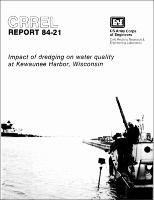Please use this identifier to cite or link to this item:
https://hdl.handle.net/11681/9542Full metadata record
| DC Field | Value | Language |
|---|---|---|
| dc.contributor | United States. Army. Corps of Engineers. Detroit District | - |
| dc.contributor.author | Iskandar, I. K. (Iskandar Karam), 1938- | - |
| dc.contributor.author | Cragin, James H. | - |
| dc.contributor.author | Parker, L. V. (Louise V.) | - |
| dc.contributor.author | Jenkins, Thomas F. | - |
| dc.date.accessioned | 2016-06-20T13:42:22Z | - |
| dc.date.available | 2016-06-20T13:42:22Z | - |
| dc.date.issued | 1984-08 | - |
| dc.identifier.uri | http://hdl.handle.net/11681/9542 | - |
| dc.description | CRREL Report | - |
| dc.description | Abstract: Six sediments and four water samples were collected from Kewaunee, Wisconsin, in 1981, prior to dredging of this Lake Michigan harbor. A modified elutrate test was used to estimate potential impact on water quality upon harbor dredging and disposal of the sediments in a confined facility. The modification of the test included a comparison between containment release under aerated vs unaerated conditions and filtered vs unfiltered elutrates. Statistical analysis showed that the differences in the chemical characteristics between the filtered and unfiltered samples were significant for soluble reactive P and all the tested metals except Cu. Significant but low amounts of heavy metals (Cd, Pb, Zn, Ni, Fe, Mn) and soluble reactive P will be released to the water if the effluent is not fIltered. Under aerated conditions, COD in both the filtered and unfiltered samples was higher than under unaerated conditions. In contrast, total organic carbon was much higher under the unaerated condition than under aerated conditions. The study concluded that sediment and contaminant releases from the confined disposal facility (CDF) to the harbor water were less than those from the Kewaunee River input. Also, retention of effluent in the CDF for about four days decreased the suspended solids in the effluent to about 40 to 50 mg/L, which is similar to the concentration in the lake water. The use of sand filters should not be for routine operation but rather for emergency cases when there is not enough time for effluent retention in this CDF. | - |
| dc.publisher | Cold Regions Research and Engineering Laboratory (U.S.) | - |
| dc.publisher | Engineer Research and Development Center (U.S.) | - |
| dc.relation | http://acwc.sdp.sirsi.net/client/en_US/search/asset/1006684 | - |
| dc.relation.ispartofseries | CRREL report ; 84-21. | - |
| dc.rights | Approved for public release; distribution is unlimited. | - |
| dc.source | This Digital Resource was created from scans of the Print Resource | - |
| dc.subject | Dredged materials | - |
| dc.subject | Dredging | - |
| dc.subject | Kewaunee Harbor (Wis.) | - |
| dc.subject | Great Lakes | - |
| dc.subject | Harbors | - |
| dc.subject | Sediments | - |
| dc.subject | Wastes (industrial) | - |
| dc.subject | Water quality | - |
| dc.title | Impact of dredging on water quality of Kewaunee Harbor, Wisconsin | - |
| dc.type | Report | en_US |
| Appears in Collections: | CRREL Report | |
Files in This Item:
| File | Description | Size | Format | |
|---|---|---|---|---|
| CR-84-21.pdf | 1.15 MB | Adobe PDF |  View/Open |